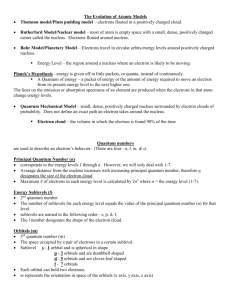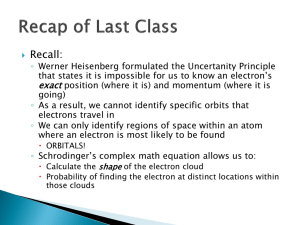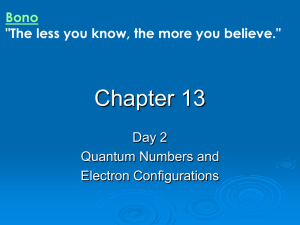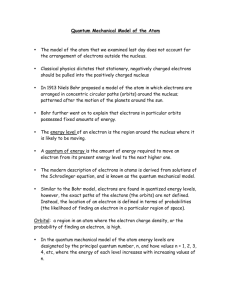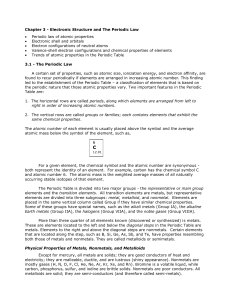Unit 2: Structure of Matter Content Outline: Modern Quantum Model
advertisement
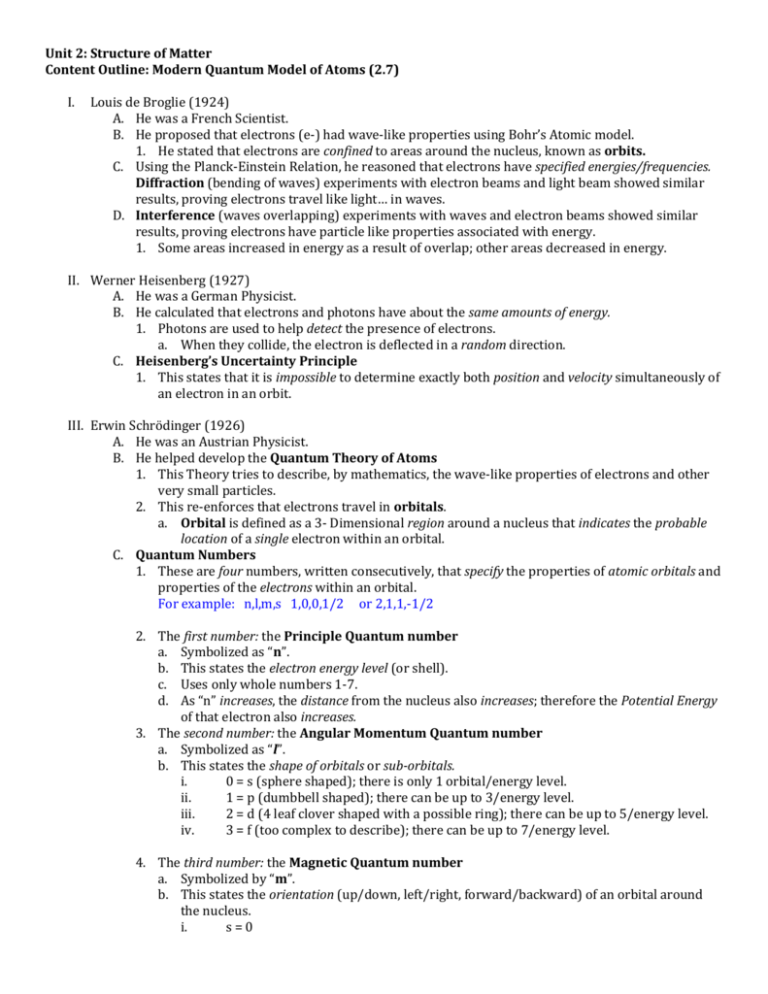
Unit 2: Structure of Matter Content Outline: Modern Quantum Model of Atoms (2.7) I. Louis de Broglie (1924) A. He was a French Scientist. B. He proposed that electrons (e-) had wave-like properties using Bohr’s Atomic model. 1. He stated that electrons are confined to areas around the nucleus, known as orbits. C. Using the Planck-Einstein Relation, he reasoned that electrons have specified energies/frequencies. Diffraction (bending of waves) experiments with electron beams and light beam showed similar results, proving electrons travel like light… in waves. D. Interference (waves overlapping) experiments with waves and electron beams showed similar results, proving electrons have particle like properties associated with energy. 1. Some areas increased in energy as a result of overlap; other areas decreased in energy. II. Werner Heisenberg (1927) A. He was a German Physicist. B. He calculated that electrons and photons have about the same amounts of energy. 1. Photons are used to help detect the presence of electrons. a. When they collide, the electron is deflected in a random direction. C. Heisenberg’s Uncertainty Principle 1. This states that it is impossible to determine exactly both position and velocity simultaneously of an electron in an orbit. III. Erwin Schrödinger (1926) A. He was an Austrian Physicist. B. He helped develop the Quantum Theory of Atoms 1. This Theory tries to describe, by mathematics, the wave-like properties of electrons and other very small particles. 2. This re-enforces that electrons travel in orbitals. a. Orbital is defined as a 3- Dimensional region around a nucleus that indicates the probable location of a single electron within an orbital. C. Quantum Numbers 1. These are four numbers, written consecutively, that specify the properties of atomic orbitals and properties of the electrons within an orbital. For example: n,l,m,s 1,0,0,1/2 or 2,1,1,-1/2 2. The first number: the Principle Quantum number a. Symbolized as “n”. b. This states the electron energy level (or shell). c. Uses only whole numbers 1-7. d. As “n” increases, the distance from the nucleus also increases; therefore the Potential Energy of that electron also increases. 3. The second number: the Angular Momentum Quantum number a. Symbolized as “l”. b. This states the shape of orbitals or sub-orbitals. i. 0 = s (sphere shaped); there is only 1 orbital/energy level. ii. 1 = p (dumbbell shaped); there can be up to 3/energy level. iii. 2 = d (4 leaf clover shaped with a possible ring); there can be up to 5/energy level. iv. 3 = f (too complex to describe); there can be up to 7/energy level. 4. The third number: the Magnetic Quantum number a. Symbolized by “m”. b. This states the orientation (up/down, left/right, forward/backward) of an orbital around the nucleus. i. s=0 ii. p = 1, 0, -1 (are possible) iii. d = 2, 1, 0, -1, -2 (are possible) iv. f = 3, 2, 1, 0, -1, -2, -3 (are possible) 5. The fourth number: the Spin Quantum number a. Symbolized as “s” b. As each orbital can only hold two negatively charged electrons, they must be opposites in spin (motion). c. We use either +1/2 (up) or -1/2 (down) for this. IV. Orbital Electron Configuration Models A. These are used to help represent the electron arrangement of an atom; electrons are represented by numbers such as 1s1 for Hydrogen or 1s2 2s2 2p5 for Fluorine or as arrows, either B. It is important to remember that each orbital can only hold 2 electrons maximum. C. You “build the model” starting from the ground state (lowest energy level) and work upward, starting at 1s1 ; the exponent states the number of electrons present at that level… hint look at the periodic table ROWS. Highest is row 7. D. This uses 3 rules: 1. Aufbau Principle (“aufbau” is German for “to build”) a. Electrons occupy the lowest energy level first that can receive the electron. Starting at 1s and work toward row 7. 2. Pauli Exclusion Principle a. Contributed by Wolfgang Pauli, an Austrian physicist. b. No 2 electrons, in the same atom, can have the same 4 Quantum numbers. 3. Hund’s Rule a. Contributed by Friedrich Hund, a German Physicist. b. States that orbitals and sub-orbitals of equal energy are each occupied by a solo electron before a second electron is entered into the orbital or sub-orbital and all electrons in singly occupied orbitals/sub-orbitals must have the same spin number. (Start with =1/2 ; then go back and use -1/2 ) V. Noble Gas Electron Configuration A. This method is used to shorten the traditional model building. B. Starting at Neon (Ne), you can begin the notation using a Noble gas first. 1. The Noble Gas must be in [ ]. Then start with the next energy row.


